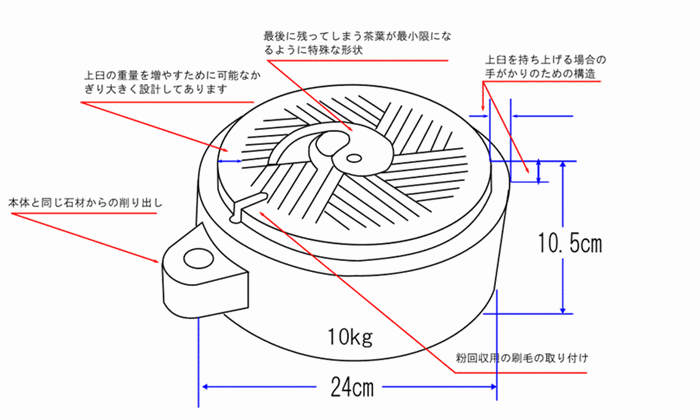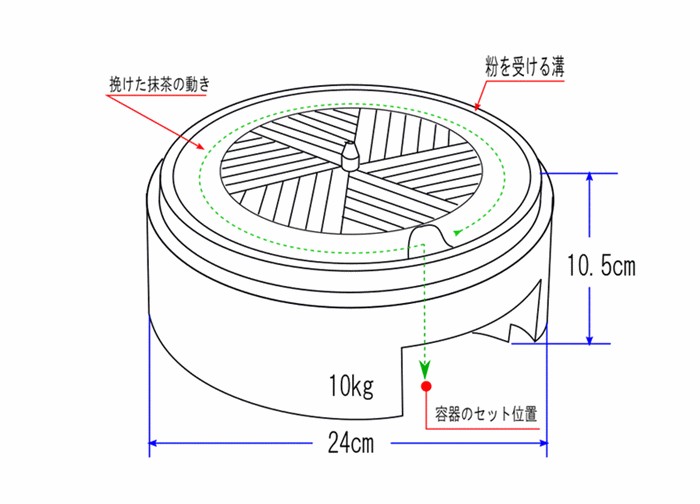



電話: 0969-24-4822
Vibrant Color: Freshly ground matcha has a vibrant green color.
Over time, it oxidizes and its color becomes dull, but freshly ground matcha maintains a particularly beautiful green color.
Rich Aroma: Freshly ground matcha has a very fresh aroma.
It exudes the rich fragrance characteristic of matcha, which can be enjoyed even before drinking.
Intense Flavor: Freshly ground matcha has a rich flavor, with a strong sense of sweetness and umami.
Compared to older matcha, the taste is significantly different.
Enhanced Health Benefits: Matcha contains many antioxidants and vitamins, but freshly ground matcha allows these components to be absorbed more effectively.
When enjoying matcha, it is recommended to choose freshly ground whenever possible.



Features of the Upper Millstone Design
The maximum outer circumference is 24cm, the grinding surface (the actual part that grinds the powder) is 15cm, height is 10.5cm, and weight is approximately 10kg.
Compared to the hand-cranked matcha mills generally sold, this is designed to be much larger and heavier.
The process of grinding tencha into fine matcha powder is typically done with a large electric millstone, which grinds slowly.
It is originally impossible to grind tencha with a small, hand-cranked millstone, but there are many products marketed as matcha mills despite producing insufficiently fine particles.
While these products can grind the tencha into a powder, the powder is rough and does not meet the standard of matcha.
Some products even claim to be able to grind anything from "matcha, soba, to coffee," which is an unreasonable expectation.
The matcha mills I produce are specifically designed to grind tencha and are not intended for grinding anything else.
For instance, coffee millstones have a different design that cannot grind tencha, and soba mills are much larger, around 30kg for both upper and lower millstones, with deeper grooves.
The upper millstone is designed to be the maximum weight that can be handled by a delivery service within the limit of 25kg, providing a stable shape.
The grinding surface diameter is set at 15cm to ensure sufficient pressure and retention time within the mill.
There are several challenges when using a small, hand-cranked millstone under less favorable conditions:
1. Can it grind the tencha into sufficiently fine particles to be called matcha?
2. Can it be turned with reasonable effort by anyone?
3. Can it achieve a practical grinding efficiency?
4. Can it grind small quantities, like enough for one or two servings, without significant loss (minimizing material left inside the millstone)?
While it was not possible to completely solve all four of these issues simultaneously, the design strikes the best balance to address each one.
Specifically, the diameter of the upper millstone is larger than the diameter of the "grinding surface."
The groove depth is very shallow at 2-3mm, but extremely hard stone material is used to counteract wear.
To minimize the material left inside, a unique, labor-intensive special structure has been added to the groove design.

Features of the Lower Millstone Design
The design ensures that you don't need to use a brush to gather the powder after grinding.
There is a groove around the outer circumference of the grinding surface to collect the powder.
Precise machining of this groove and polishing the inside of the groove requires considerable skill.
A dedicated stainless steel cup will be included with the product when it is shipped to collect the powder.

Since last year, my stone workshop, Yoshida, has started collaborating with a matcha shop in New Jersey, USA, to expand the use of matcha mills in America.
Furthermore, starting this year, we have also begun overseas sales of matcha mills and coffee mills.
Matcha is rich in catechins, which have strong antioxidant properties, as well as vitamin C and amino acids, making it beneficial for health.
Matcha is now recognized as a "superfood," gaining attention for its high nutritional value. It is packed with antioxidants, vitamins, and minerals.
Compared to coffee, matcha contains less caffeine and includes the amino acid L-theanine, which has relaxing effects. This makes it popular as a coffee alternative, as it can enhance concentration while providing relaxation.
Matcha is deeply connected to the traditional Japanese tea ceremony, and as interest in Japanese culture grows, matcha is also gaining attention. With the global spread of Japanese culture through anime, movies, and tourism, matcha is becoming increasingly popular as part of this cultural wave.
There is a growing number of foods and beverages that utilize the flavor of matcha, such as matcha lattes, matcha ice cream, and matcha chocolate. Especially in cafes and restaurants, menus featuring matcha are becoming more common.
There are also skincare products that take advantage of the antioxidant properties of matcha.
Tourist experiences offering matcha activities and tea ceremony experiences are gaining popularity. Tourists are increasingly enjoying matcha as part of experiencing Japanese culture.